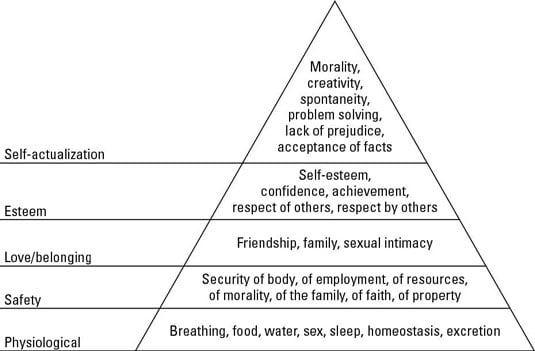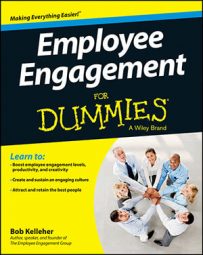Here are the five levels in Maslow's hierarchy of needs, and how you can apply them to the workplace to engage your employees. Maslow's hierarchy of needs is a psychology theory posed by Abraham Maslow in his 1943 paper, “A Theory of Human Motivation.”
According to this theory, all people have needs that must be satisfied. Maslow used a pyramid to describe and categorize these needs, as shown in the figure. Needs on the bottom of the pyramid must be met before needs on the next level can be addressed.

Here are the needs and how they apply to your employees:
Psychological: To survive, people need air, food, water, sleep, and so on. How does this relate to employee engagement? Employees need a comfortable work environment.
If your employees work in conditions of extreme hot or cold, they probably won't advance to the next level in the pyramid — they simply won't have the motivation. Similarly, employees need access to such things as restroom breaks, food, drinks, and so on.
Safety: People must feel that they, their family, their property, and other resources are safe. When it comes to the workplace, if employees have to worry about their personal safety (for example, getting hurt or sick at work) or their professional security (read: losing their jobs), morale will suffer.
Ensuring a safe workplace may include providing ergonomic furniture and/or securing the building. Job security is also key.
Love/belonging: Not surprisingly, creating a sense of belonging is a key aspect of building an engaged culture. In its highly regarded Q12, which is a measure of employee engagement, Gallup includes the following question: “Do you have a best friend at work?” Why does this question matter?
Because based on Gallup's research, employees who answer in the affirmative are more likely to be engaged than those who don't. This is directly attributed to Maslow's third level of love and belonging. Companies with a history of social and other camaraderie-building activities have higher degrees of employee engagement than companies that are all business, all the time.
Although employee perks like ping-pong tables and beer-cart Fridays are not employee engagement drivers in and of themselves (instead, they're satisfiers), they do help create an atmosphere of love and belonging.
Esteem: Esteem is a person's belief that she is doing a good job and that her contributions are recognized. People want to feel that they're achieving and that their contributions matter and are recognized.
Confidence is key. Any educator or coach will tell you, if a student or player has confidence, that person will shine. The same principle holds true in the workplace. If employees believe in themselves — and believe (thanks to recognition) that others believe in them — they'll be more engaged and productive.
Employee recognition is a key part of engagement. At its core, recognition builds esteem. Unfortunately, even though recognition has so much impact — and is often free — it remains low on most companies’ list of priorities.
Self-actualization: In the workplace, self-actualization translates to maximizing one's true potential. Employees want to be the very best at what they do, and the manager's job is to help them realize that. With self-actualization, employees feel trusted and empowered — in control of their jobs and their futures.
A key aspect of self-actualization is ensuring that employees are only put in positions for which they are capable. Sure, employees should feel challenged, but you don't want them to be in over their heads. Ultimately, this erodes engagement, as employees begin to doubt themselves.
You can't fully engage your employees if the employees’ needs aren't being satisfied. For example, during a companywide layoff, engagement levels will be low. Even star employees who are at no risk of losing their jobs will worry.
Why? Because the layoff has resulted in a failure to meet employees’ level-two needs: safety and security. Employees don't feel secure. Even employees who know that their jobs are safe will worry about the company's future. (This explains why companies often see a spike in voluntary turnover after a companywide layoff. When people feel their jobs or employer is no longer secure, they often look for new opportunities to regain their sense of security.)
A healthy, fully engaged workforce is one that has collectively reached level five, or self-actualization. This occurs in organizations that have built a line of sight between where the company is going and each employee's job or role. Level five is where you win over employees’ heads and hearts. Fortune magazine's annual Top 100 Best Companies to Work For is full of companies that have reached level five.
Unfortunately, we're not all so lucky to work for such enlightened companies. Therefore, it's incumbent on managers to really get to know their employees so they can maximize their engagement. The old “Treat people the way you want to be treated” rule no longer applies. These days, it's “Treat people the way they want to be treated.” That means knowing what motivates them.

